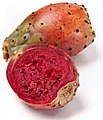Cookbook:Fruit
| Fruit | |
|---|---|
 | |
| Category | Basic foodstuffs |
Cookbook | Recipes | Ingredients | Basic foodstuffs
The concept of a fruit in a culinary sense is fairly arbitrary, and it differs from the botanical sense of the word. Consequently, items that are botanically classified as fruits, but are usually referred to in cooking as "vegetables" (such as the tomato) will be in the vegetables section, and not here. For a discussion of the botanical vs. culinary definitions of that part of a plant called the "fruit" see Fruit at Wikipedia.
Classification[edit | edit source]
Because foods considered fruits have a wide range of native habitats, characteristics, uses, and phylogenies, it is extremely difficult to divide them into discrete categories. This page addresses a few different characteristics.
Berries[edit | edit source]
In the culinary sense, berries are typically very small fruits, often (but always) with negligible seeds. It is a somewhat arbitrary category, and different cultures may have different definitions of the term. Culinary berries should not be confused with botanical berries.
Climate[edit | edit source]
Temperate fruits[edit | edit source]
Fruits of temperate climates are almost universally borne on trees or woody shrubs or lianas. They will not grow adequately in the tropics, as they need a period of cold (a chilling requirement) each year before they will flower. The apple, pear, cherry, and plum are the most widely grown and eaten, owing to their adaptability. Many other fruits are important regionally but do not figure prominently in commerce. Many sorts of small fruit on this list are gathered from the wild, just as they were in Neolithic times. The Rosaceae dominates the temperate fruits, both in numbers and in importance. The pome fruits, stone fruits, brambles, and strawberry are all members of Rosaceae.
Mediterranean and subtropical fruits[edit | edit source]
Fruits in this category are not hardy to extreme cold, as the preceding temperate fruits are, yet tolerate some frost and may have a modest chilling requirement. Notable among these are natives of the Mediterranean.
Tropical fruits[edit | edit source]
Tropical fruit share an intolerance of frost.
Use[edit | edit source]
Due to their sheer variety and diversity, fruits are used in a wide variety of cuisines. There exist many fruits that are edible and locally popular but for various reasons have not become widespread in their use. Often this is due to marketing considerations, more than anything.
Index[edit | edit source]
For an alphabetical list of fruits in the Cookbook, see Category:Fruits or browse below:
Gallery[edit | edit source]
- Temperate Fruits
-
Strawberry
-
Watermelon
-
Apple
-
Pears
-
Blueberries
-
Blackberries
-
Apricot
-
Cranberries
-
Quinces
-
Raspberries
-
Plum
-
Nectarine
-
Prickly pear
- Subtropical fruits
-
Mandarins
-
Lemon
-
Kumquat
-
Sweet orange
-
Lychee
-
Longan fruit
-
Pomegranate
-
Dates
-
Fig
-
Grapes
-
Feijoa
- Tropical Fruits
-
Pineapple
-
Starfruit
-
Banana
-
Papaya
-
Breadfruit
-
Tamarind
-
Mango
-
Durian
-
Coconut
-
Akee
-
Jackfruit
-
Passionfruit
-
Rambutan
-
Cherimoya





































